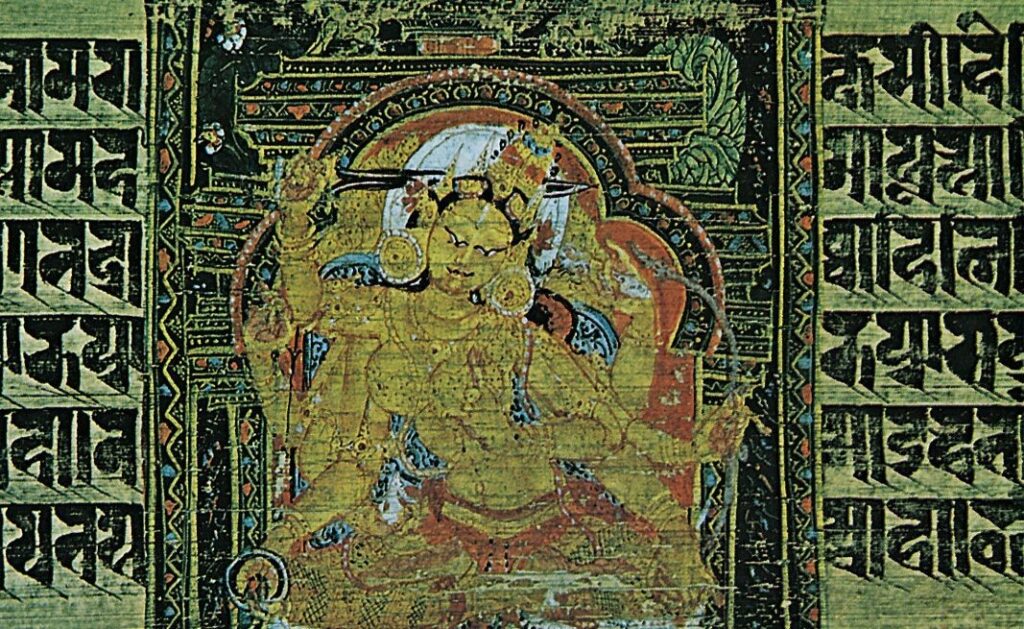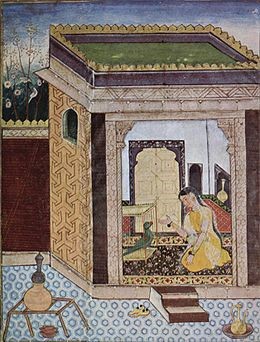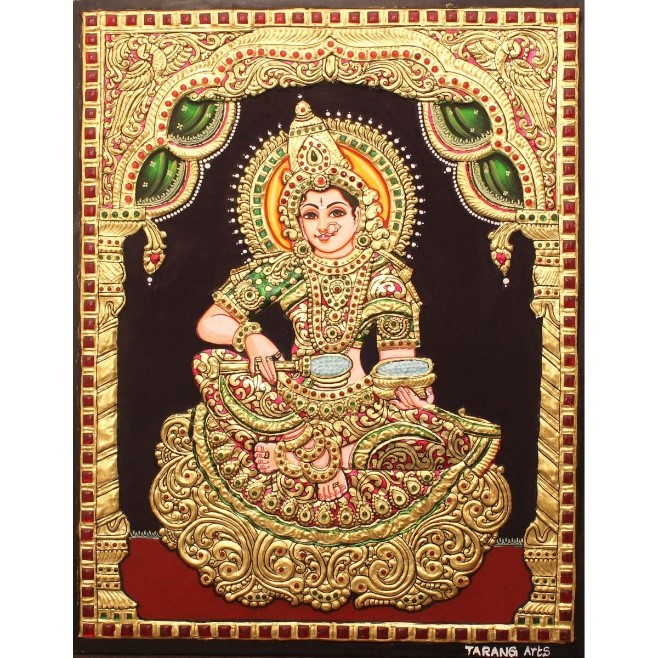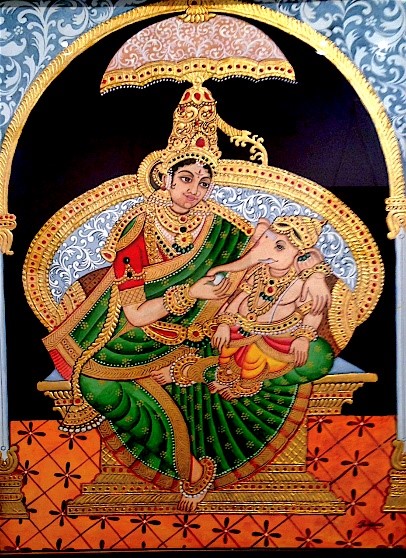Miniature painting is a traditional style of art that is very detailed and generally done using water colour on cloth or paper. In this article, you will learn definition, techniques and various schools of Miniature painting.
This article will provide key insights for GS Paper-I of Art and Culture section of UPSC IAS Exam.
Table of Content
- What is the miniature painting?
- Techniques of Miniature Paintings
- Early Miniature art in India
- The Pala School of art
- The Apabhramsa School of Art
- Transition Period Miniature
- Miniature Art during Delhi Sultanate
- Mughal school of Miniature Painting
- Early Mughal Painters
- Miniature Painting during reign of Akbar
- Miniature Painting during reign of Jahangir
- Miniature Painting during reign of Shah Jahan
- Miniature Painting during reign of Aurangzeb
- Miniatures in South India
- Tanjore School of Paintings
- Mysore School of Paintings
- Conclusion
- Frequently Asked Questions
What is the miniature painting?
- The Miniature painting is a traditional style of art that is very detailed and generally done using water colour on cloth or paper.
- The term ‘miniature’ originates from the Latin word ‘Minium‘.
- It means red lead paint which was used in manuscripts during the Renaissance era.
Techniques of Miniature Paintings:
- Requirements that should be met when creating Miniature paintings:
- The size of the painting should not exceed 25 square inches.
- The subject depicted in the painting should not be more than 1/6th of its actual size.
- In many Indian miniature paintings, human figures are portrayed in side profile.
- Human figures in Indian miniature have prominent eyes, pointed noses, and slender waists.
- In Rajasthani miniatures, the human figures have brown skin, while in Mughal paintings, human figures were fairer.
- Divine beings like Lord Krishna have a blue complexion.
- Women figures have long hair, and their eyes and hair are generally black.
- Men usually wear traditional clothing and adorn turbans on their heads.
Early Miniature art in India:
- The Miniature paintings were commonly created for books and albums or perishable materials such as paper, palm leaves, and cloth.
- Indian miniature paintings emerged as a response to the large-scale wall paintings.
- The Miniature paintings was developed between the 8th to the 12th centuries.
- 2 prominent schools: the Pala School of Art and the Apabhramsa School of Art.
The Pala School of art:
- The Pala School of art was developed between the 750-1150 AD.
- The Pala School of art was executed on manuscripts and were skilfully crafted on materials such as palm leaf or vellum paper.
- This art was primarily favored by Buddhist monks, who while adhering to the philosophy of non-violence towards all living beings used only leaves from banana or coconut trees.
- The art has graceful, curving lines and subtle, muted tones in the background imagery.
- Singular figures dominated the scenes but group compositions were rare.
- The Pala School of art were favoured by rulers who actively promoted Buddhism.
- The Vajrayana school of Buddhism supported these paintings, where Dhimman and Vitapala were renowned artists.

The Apabhramsa School of Art:
- The Apabhramsa School of Art originated from Gujarat and the Mewar region of Rajasthan.
- This school of painting was prominent in western India from the 11th to the 15th century.
- Prominent themes: Jain and the later Vaishnava School
- Vaishnava School introduced the concepts of Gita Govinda and secular love.
- During the early Jain phase, palm leaf was used as the canvas for these paintings, but slowly they transitioned to paper.
- Despite being created for book illustrations, they retained a mural-like quality in a smaller format.
- Colors had symbolic meaning such palette with red, yellow, and ochre were commonly used.
- Butlater vibrant and golden hues were used.
- The human figures have features such as fish-shaped bulging eyes, a pointed nose, and a double chin.
- The Apabhramsa School of Art started depicting angular faces in the third and fourth profile.
- The figures have a sense of rigidity.
- Female figurines showcase enlarged hips and breasts whereas animals and birds were portrayed as toys.
- Example: 15th-century Kalpasutra and the Kalakacharya Katha.
Jain miniature paintings:

Transition Period Miniature:
- The arrival of Muslim rulers in the Indian subcontinent during the 14th century brought transformative change in miniature paintings.
- In the courts of western India, the traditional styles were persevered and a cultural synthesis took place.
- In the southern regions, particularly in Vijayanagara, a distinct style emerged that were similar to the deccan miniature painting.
- It employed a flat application of colors, with black color outlining the attire and human figures.
- The faces were portrayed from a three-quarter angle.
- This provided them a detached appearance.
- The landscapes were abundant with trees, rocks, and various other designs that did not strive to mimic the natural representation of the subjects.
Miniature Art during Delhi Sultanate:
- These paintings blended Persian influences with traditional Indian elements.
- They focused on illustrated manuscripts.
- Example: Nimatnama, a cookery book created during the rule of Nasir Shah in Mandu.
- Another style of painting- Lodi Khuladar became popular in the Sultanate-controlled regions between Delhi and Jaunpur.
- Later 3 prominent styles emerged: Mughal miniature paintings, Rajput miniature paintings, and Deccan school of miniature painting.
- They drew inspiration from the Sultanate period with their own unique character and identity.
Mughal school of Miniature Painting:
- They possessed a distinct style as they drew inspiration from naturalistic style of Persia origins.
- Persian influence underwent changes in color choices, themes, and forms.
- They glorified the ruler and showcased their life through painting.
- Common themes: Hunting scenes, historical events, and court-related imagery.
- The miniature paintings of Mughal period were illustrated with the vibrant colors, and the painters paid great attention to the precision of line drawings.
- The miniature paintings during Mughal period had introduced the technique of foreshortening to Indian painters, where objects are depicted to appear closer and smaller than their actual size.
- Famous Mughal miniature paintings – Arjuna Battles Raja Tamradhvaja, The Emperor Shah Jahan with his Son Dara Shikoh, Shah Jahan on Horseback etc.
Mughal miniature floral paintings:

Early Mughal Painters:
- Babur had supported the Persian artist Bihzad, who had illustrated the Mughal family tree.
- Humayun took a keen interest in paintings and the construction of magnificent monuments.
- However, his pursuits were disrupted when he was dethroned by Sher Shah Suri and forced into exile in Persia.
- Humayun brought 2 painters- Abdus Samad and Mir Sayyid Ali form Persia.
- They infused Persian influences into Mughal paintings, producing many illustrated albums.
- Example: Tutinama created during Akbar’s reign that recounted the tale of a parrot.
Miniature Painting during reign of Akbar:
- Akbar had established a dedicated department for paintings and document scribing.
- Akbar had created a formal artistic studio known as Tasvir Khana, where artists were employed and developed their unique styles.
- Akbar viewed paintings as a means of both study and entertainment.
- Akbar believed that a painting could capture the essence of its subject.
- Akbar frequently rewarded painters who produced lifelike images.
- Akbar appreciated the talent of Indian artists who had previously served under other rulers and invited them to work in his Tasvir Khana.
- This marked the beginning of the “Indian influence” in Mughal paintings.
- The miniature painting of Akbar used 3-dimensional figures and the consistent application of foreshortening techniques.
- Artists incorporated calligraphy into their paintings.
- There was shift from popular art to courtly art, with a greater focus on depicting scenes from court life rather than the lives of the common people.
- Renowned painters: Daswant, Basawan, and Kesu.
- Prominent manuscripts with minitature paintings: Tutinama, Hamzanama, Anvar-i-Suhaili, and Gulistan of Sadi.
Tutinama:

Miniature Painting during reign of Jahangir:
- During the reign of Jahangir, Mughal paintings had reached their pinnacle.
- Jahangir had incorporated nature in his paintings by particularly favouring artworks depicting flora and fauna, including birds, animals, trees, and flowers.
- Jahangir had emphasized the portrayal of naturalistic elements in portrait painting.
- Jahangirhadincorporated decorative margins around the paintings, where many of them were painted with intricacies as the paintings themselves.
- Jahangir himself possessed artistic talents and maintained his own personal workshop.
- No significant works created by him have survived till date.
- Famous paintings: zebra, turkey, cock and an animal fable- Ayar-i-Danish (Touchstone of Knowledge).
- Renowned painters:
- Ustad Mansoor excelled in capturing the intricate features of complex faces.

Miniature Painting during reign of Shah Jahan:
- In contrast to his father and grandfather’s preference for naturalistic portrayals, he introduced artificial elements into the artworks.
- Shah Jahan aimed to diminish the liveliness of the paintings and introduce an unnatural sense of stillness.
- He drew this inspiration from European influences.
- Shah Jahan had brought changes in the drawing and painting techniques employed during the earlier period.
- Shah Jahan discouraged the use of charcoal and instead encouraged artists to utilize pencils for their sketches and drawings.
- Shah Jahan emphasized the use of gold and silver in the paintings.
- Shah Jahan had preferred brighter color palettes ascompared to his predecessors.

Miniature Painting during reign of Aurangzeb:
- Under Aurangzeb’s rule, there was a lack of support for painting, leading to a migration of Mughal court painters to provincial courts, particularly in Rajasthan and other regions.
- The artistic endeavours related to painting experienced a decline during his reign.
Miniatures in South India:
- Miniatures in South India was developed during the early medieval period in the South Indian states.
- Miniatures in South India was abundantly decorated with the gold.
- Miniatures in South India shifted towards depicting divine beings rather than the rulers who provided patronage to the artists.
- Major schools: Tanjore Paintings; Mysore Paintings
Tanjore School of Paintings:
- The Thanjavur or Tanjore School gained patronage from the Maratha rulers in the 18th century.
- The Tanjore School of Paintings were predominantly created on glass and board.
- Northern India paintings preferred painting on cloth and vellum.
- The Tanjore School of Paintings was characterised by the vibrant color patterns and use of gold leaf.
- The Tanjore School of Paintings had incorporated various gemstones and cut glass for embellishments, resulting in larger-than-life images.
- Majority of the artworks had portrayed a smiling Krishna in different poses and depicting significant events from his life.
- Under the patronage of Sarfoji Maharaj, this school reached its pinnacle.
- The Tanjore School of Paintings still continues to thrive, but with diverse subjects such as birds, animals, and buildings, etc.

Mysore School of Paintings:
- The rulers of the Mysore province were patrons of these paintings.
- Their popularity continued during the British period as well.
- The main focus of Mysore paintings is the portrayal of Hindu deities.
- Uniqueness: each artwork had two or more figures, where one figure had size and colour.
- They utilize a mixture called ‘gesso paste,’ comprising zinc oxide and Arabic gum, which provided a glossy background.
- To achieve balance with the glossy background, muted colors were used that avoided excessive brightness that may conflict with the background.

Conclusion
In conclusion, miniature paintings in India have a rich and diverse history. They have been prevalent in various regions and periods, each with its unique characteristics and styles. From the intricately detailed Mughal miniatures to the Jain miniature paintings, these art forms have captivated audiences for centuries and carried forward the Indian tradition in their own elegant manner.
| Other Articles in History & Culture | |
| Aryabhatta | Pandya Dynasty |
| Modern Indian Painting | Religion & Culture during Gupta Period |
| Social Development during Gupta Period | Kakatiya Dynasty |
FAQs (Frequently Asked Questions)
What is miniature painting?
The Miniature painting is a traditional style of art that is very detailed and generally done using water colour on cloth or paper.
The miniature painting was developed in which part of India?
The Miniature painting was developed in the Western Indian Himalayas during 17th century A.D.
What is the difference between the Mughal and deccan school of miniature painting?
The deccan school of miniature painting used excess of golden or bright colors and were less realistic than the Mughal painting
Where did the Mughal school of miniature painting originated?
The Miniature painting originated from Persian miniature painting and was developed in the court of the Mughal Empire from 16th to 18th centuries.
What is the difference between mural and miniature painting?
The mural paintings are large paintings executed on the wall whereas miniature painting are very small and are executed on books or papers etc.


